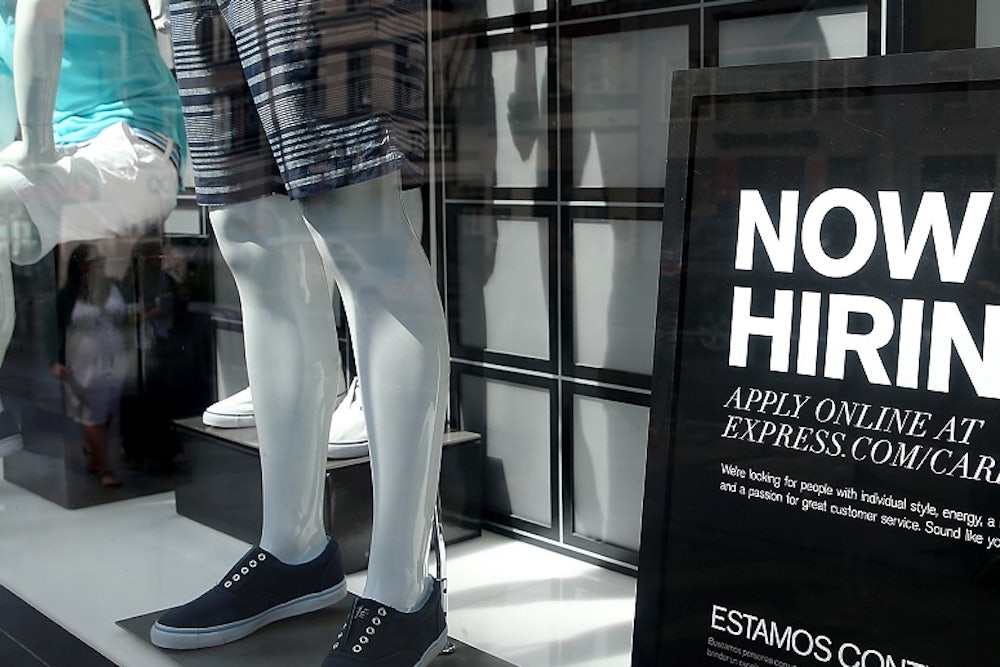After a worrisome August jobs report, the Bureau of Labor Statistics reported Friday morning that the economy added 248,000 jobs in September, beating expectations of 215,000. The unemployment rate also fell to 5.9 percent, the lowest it’s been in six years.
But just as there was no reason to freak out after August’s subpar numbers, we shouldn’t celebrate too much with Friday’s report as well. Wages still aren't growing and millions of Americans are still looking for work. In addition, monthly reports are notoriously noisy. A better way to look at the data is through the three-month moving average:

As you can see, the economy certainly has strengthened over the past six months and is in better shape. We are consistently adding more than 200,000 jobs a month. Even better, the July and August reports were revised up a combined 69,000. In addition, long-term unemployment—those unemployment for more than 27 weeks—continued its long, slow decline, but is still near three million.
It wasn’t all good news though. The labor force participation rate declined slightly to 62.7 percent from 62.8 percent. That’s the lowest it’s been since the late 1970s. Economists are still debating how much of this decline is the result of long-term structural forces—like baby boomers retiring—or cyclical ones that will draw workers back into the labor force as the economy improves.
It’s an important question that has significant implications for monetary policy. If the decline in the participation rate is largely structural, that means workers won’t reenter the labor force even as the economy strengthens. In that scenario, the current unemployment rate of 5.9 percent is an accurate indicator of the health of the labor market and we will reach full employment in the near future. If this is true, then the Federal Reserve should raise interest rates soon to prevent moderate inflation.
But if the fall in the labor force participation rate has a cyclical component, that means more workers will enter the labor force as the economy recovers. That could even raise the unemployment rate over the next few months. With a larger amount of unemployed workers, employers won’t have to increase wages to hire employees. And that won’t put any upward pressure on inflation, allowing the Fed to keep interest rates at zero for a longer time.
It’s hard to know which of these views is correct. Although the recovery has strengthened in recent months, the labor force still isn’t rebounding. Economists are less hopeful that discouraged workers who exited the workforce will actually return. That would be a human disaster as millions of able-bodied workers would be lost from the labor market forever, reducing long-term growth.
But there is one glaring sign that there is still slack in the labor market: wages are stagnant. In September, wages grew 0.0 percent, below expectations of 0.2 percent. Over the past year, wages have grown just 2.0 percent, barely keeping up with inflation. Wages will rise when employers have to compete for scarce labor—i.e. when the economy is at or near full employment. That clearly isn’t the case right now, meaning the 5.9 percent unemployment rate doesn’t represent the current state of the labor market. If the Fed were to raise interest rates, it would choke off the recovery and prevent any wage growth.
Ten days ago, the Pete Peterson Institute held a conference in Washington D.C. with some of the country’s top economists to discuss the current state of the labor market—and try to figure it out. Charles Evans, the president of the Chicago Federal Reserve, delivered a speech at the event where he laid out his proposed path for monetary policy. In particular, he outlined his belief that we should not raise interest rates in the near future. “I am very uncomfortable with calls to raise our policy rate sooner than later,” he said. “I favor delaying liftoff until I am more certain that we have sufficient momentum in place toward our policy goals.” He specifically noted that the risks of raising rates prematurely and choking off the recovery far outweigh the risks of raising rates too late and allowing for moderate inflation.
If the September jobs report delivers any particular message, it is exactly what Evans preached: patience. Wages still aren’t rising. Even though the unemployment rate is now below 6 percent, that’s a clear sign that slack still exists in the labor market. There’s no reason for the Fed to rethink its zero-interest-rate policy anytime soon.
